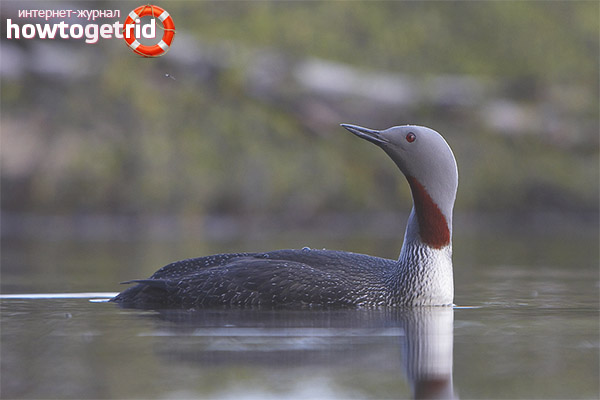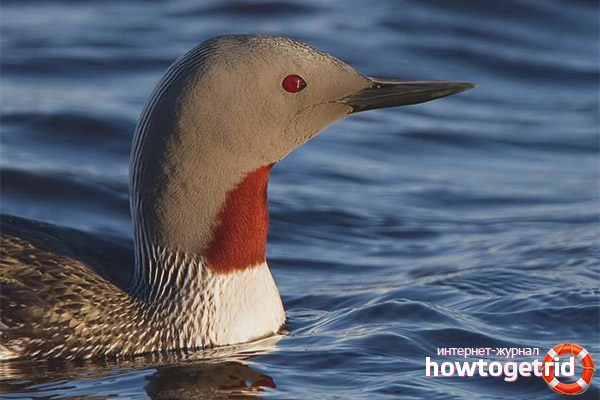The content of the article
The red-throated loon is a bird from the loon genus that boasts its most ancient history. The ancestors of this amazingly beautiful bird flew over the earth more than 30 million years ago. The red-throated loon is the smallest of the kind, weighs only 1.5-2 kg. This is an elegant bird with a long beak, which is very interesting to watch.
The appearance of the red-throated loon
The length of the body of the feathered representative is 50-70 cm, the wingspan is a little more than a meter. The upper part of the body and wings seem to be uniformly gray, however, when approaching, you can notice small white spots concentrated on the neck. The abdomen of the bird is light, almost white. A characteristic feature of the bird is a reddish and reddish spot on the front of the neck. Despite the rather bright color, the spot is noticeable only at close range; it cannot serve as a defining sign. The beak of the bird is quite thin, slightly bent top. In addition, the loon has the habit of keeping it a little upturned, which is why many people call the bird “snub”. By the color of the beak, you can determine the age of the individual - in young people it has a gray tint with black bordering, in mature loons the beak is completely black. The legs of the loon are also black, with barely noticeable pink membranes.
Habitat
Bird lifestyle features
Today, the loon is considered an endangered species and is strongly protected by environmental organizations. The cause of the problem is the widespread pollution of the natural habitat. In the dirty water of the loon, it is more difficult to look for food, birds die from heavy metal poisoning. Until recently, fishermen were actively exterminating the birds; moreover, the loons were confused in the set fishing nets. Today, the red-throated loon population is recovering in every way possible; artificial mounds and islets are even being built on large lakes in North America to attract a bird population.
The red-throated loon feels great in the water, moves perfectly, dives and swims superbly. In case of danger, the loon can completely submerge in water, leaving only the head and a narrow strip of neck on the surface. The ability to control the body is simply amazing - the loon can swim on its side, often stands on the surface of the water, flapping its wings, and in some cases it is able to swim even upside down with its belly up. The loon is able to hold air for a whole minute, and also dive deep into the water column for 10 meters or more. In flight, the loon resembles a duck, although it has larger and back legs. In the air, the red-throated loon is a loner who does not even let her partner get too close. On land, the loon walks quite rarely, moving along with the abdomen and breast, pushing the body with its paws. The bird flies much more readily than its close relatives, in case of danger, the red-throated loon will more likely fly into the air than dive into the water.An amazing feature of the bird is its ability to rise into the air almost without a run. That is why the loon gladly nests on small lakes, and feeds on large nearby water bodies. The loons can live alone, in pairs and in small flocks of 6-8 individuals. In the period of colds and migration for wintering, the loons can form quite large flocks of up to 500 individuals.
The loon can get its own food both day and night, equally well guided in the water. The main food is any small fish. The loon swallows a small fish right under the water, and carries a large one to the surface and kills it with its powerful beak. In addition to fish, the red-throated loon can enjoy caviar, frogs and crustaceans. In early spring, when the lakes are still under ice, the bird eats the first vegetation with pleasure.
Interesting Facts
The red-throated loon is not only beautiful, but also an amazing bird, which is interesting to watch.
- During the flight, the loon is capable of speeds of 50-60 km per hour.
- When the red-throated loons fly for the winter, they do not interrupt the flight not only during the day, but also at night.
- Red-throated loon is capable of making a special sound, which is very similar to cat meow. So the bird scares away the stranger or drives him away from the nesting place.
- Red-throated loons are monogamous and form a pair for life.
- For one dive, the loon is able to swim up to one hundred meters. Her blood is perfectly saturated with oxygen, so the bird is able to hold its breath for a long time. And large and heavy bones make a great diver out of the loon, who easily plunges to the very bottom for prey.
- The eggs are hatched not only by the female, but also by the male, intently guarding the adjacent territory. When a person approaches, the female descends into the water, distracting the enemy from the nest, the bird at this moment is able to let the person as close as possible, if only he does not approach the masonry.
It is very interesting to watch a bird that greases feathers. In the process of this, the loon can take the most unusual and amazing poses, sometimes lying back in the water, smoothing feathers on the abdomen with a beak.
Red-throated loon - this is a great view of loons, which amaze not only with their exquisite appearance, but also with physical skills.
Video: Red-throated Loon (Gavia stellata)











Submit